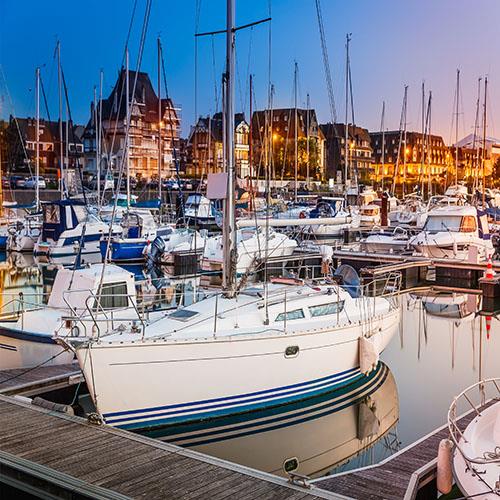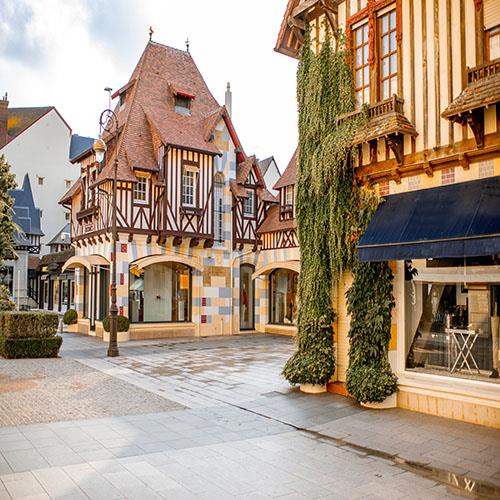EXPERIENCE COTE FLEURIE

Overview
The “flower coast” of Normandy extends from the Seine estuary in the east to the mouth of the Orne at the town Ouistreham in the west. A seaside resort joins the next one there. Deauville and its little sister Trouville, Houlgate and Cabourg are some of the well known seaside resorts. Well-kept beaches, chic casinos and of course flowers make the coast a popular holiday destination for the Parisian jet set. A typical summer stay includes visiting sailing regattas, golf tournaments or horse racing, as well as seeing and being seen on one of the chic beach promenades. During the annual film festival in Deauville, French and international stars and starlets meet on the Normandy coast.




Things to see and do
The Côte Fleurie offers fantastic film festivals (the Deauville American Film Festival in September is second only to Cannes), expansive beaches, seafood-laden local cuisine, artistic history (Monet and other Impressionists painted here), celebrity residences and elaborate casinos (Cabourg and Deauville). Below is a list of must-sees while you're visiting the Côte Fleurie.
Deauville, located between Caen, Rouen and Le Havre, was merely a farming village until the mid 19th century. This is when Charles de Morny, a half brother of Napoleon III, turned the “swamps and sand into a kingdom of elegance,” which was to become a magnet for fashionable Parisian society. Neo-Romanesque luxury hotels, a casino and a horse race track contributed to the expansion of the city. Kings, Hollywood stars, artists and composers soon came to visit. The attractions are topped off by a yacht harbor and an attractive boardwalk.
Honfleur is a picturesque harbor town that attracted famous painters, including Courbet, Renoir and Cezanne. Even today, the painters stand by the wharf and in the Greniers à Sel, the salt warehouses at the fortress. The city lies at the mouth of the Seine into the English Channel. The city center around the harbor basin is something not to be missed. Wander around and admire the narrow houses, quaint cafes, painters by the water with their easels and enjoy all the activity at the promenade. A highlight of Honfleur is the Church of Sainte Catherine, a church from the 15th century. It was built entirely of wood by ship carpenters with two twin ships and a roof construction that resembles ship hulls, and was equipped with painted glass windows and other works of art. A special feature here is that the church building and the (free-standing) church tower are placed separately from each other on the Place Sainte Catherine.
Enjoy the charms of the famous seaside resort of Trouville and admire its century-old villas. This former fishing village flourished in the 19th century with the rise in popularity of sea bathing and with the extension of the Paris-Deauville railway line. Boudin planted his easel and painted beach scenes populated with wealthy visitors. The sea in the countryside is what best defines this beautiful corner of the Côte Fleurie that some call the "Queen of Beaches". Enjoy the charming old town, you will easily find a restaurant to enjoy delicious local seafood.
Le Vieux Bassin is known as the city of painters. It offers a unique atmosphere and amazing charm, which inspired many painters such as Eugène Boudin whose famous sky-scapes explored the changing skies of Honfleur. Stroll through the town in the footsteps of those masters. Discover its picturesque streets and narrow houses covered with slate.
The best thing the Côte Fleurie in Normandy has to offer is its incredible nature. Exploring this beautiful coast is impossible without visiting the most impressive cliffs named Falaises des Vaches Noires (The Cliffs of the Black Cows). Those cliffs situated near Houlgate, a beautiful seaside resort, are a real fossil necropolis. Houlgate is also a place where you can taste “Belle du Nordet.”

History
At the end of the 19th century, after the opening of the railway line connecting the Norman coast to the French capital, the small fisherman villages in Normandy were transformed, one by one, into very fashionable seaside resorts. The wealthy businessmen were hiring famous architects to create modern and ravishing new cities. In 1860, the Duc the Morny, a half-brother of Emperor Napoleon III and the architect Desle-François Barney created Deauville, a high society seaside resort. At that time, many beautiful hotels and villas were built all along the Côte Fleurie. One of them is the Hotel des Roches Noires in Trouville. This old hotel from 1866 was even listed in August 2000 as the French historical monument. Today, the Côte Fleurie is mainly known as the Parisian Riviera. This part of Normandy is a place where Parisians just adore to come and get the necessary dose of vitamin D.

Beaches
The coastline of Calvados in Normandy extends over 75 miles from Honfleur to north of Isigny sur Mer to the south. These seaside destinations are divided into three zones: The Cote Fleurie, which is found around Deauville; Cote Nacre, found in the suburbs of Caen; and cote du bessin. The most well-known destinations are found in Deauville, Cabourg or Quistreham. These beaches are ideal at low tide to enjoy the vast stretches of sand that are perfect for shelling, swimming, and beach activities.
The Beaches in Deauville are the most fashionable beaches along the coast that extend to Villerville in Cabourg. Just next door, the Beaeches in Trouville-sur-Mer are very similar and reachable by foot from deaville, where you can just walk along the seafront to get here. The Beaches in Ouistreham played a significant role during WWII and its territory located on Sword Beach. Without a doubt, one of the most popular beach destinations in the area are the Beaches in Cabourg. No matter what beach you choose, you’ll be sure to enjoy the beauty and relaxation that the Cote Fleurie beaches have to offer.